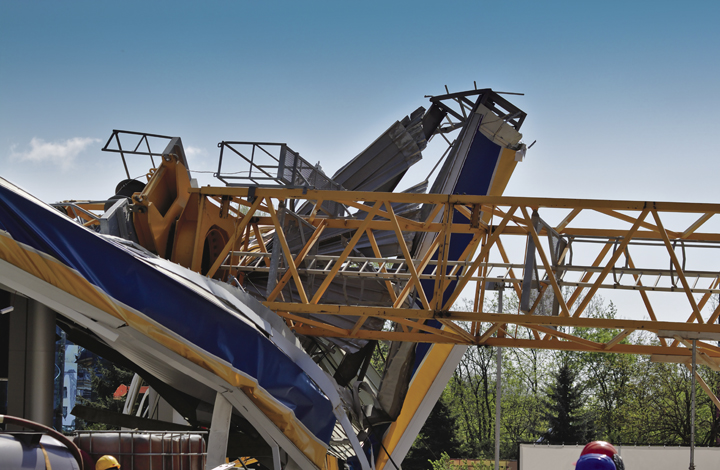A guide for those who don’t have time for YouTube videos
Do you ever wonder what causes construction cranes to collapse? What about heavy equipment mishaps—how do they come about? If you have time—and if you’re easily distracted, allow lots of time—head to YouTube.com and search “crane accidents” or “heavy equipment accidents.” You’ll find compilations of the “10 Worst” or “Real Life” accidents—hundreds of videos, often 10 minutes or more in length, many boasting more than a million views.
If you’re not inclined to follow the YouTube rabbit trail to learn about crane accidents, find a few minutes to sit down with Clayton Hartley, senior executive general adjuster for Engle Martin & Associates. He’s been adjusting crane losses for 40 years. “I handled a loss in New York last year that involved a fatality,” he recalls. “The crane fell 600 feet to the ground, and it clearly was just operator error. He wasn’t paying attention.”
Crane claim drivers
He sums up the reason behind most crane claims in a few words: “In many cases, the operators are just poorly trained.” Construction firms, he says, are having trouble finding qualified people to run their cranes. “Unemployment is only four percent. They can’t find anybody to do the work.”
Competition compounds the problem. “Companies want to control costs, and one way to do that is to hire someone who might not be the ideal candidate.” Cost issues may also lead to cuts in training budgets. Couple that with more sophisticated computerized equipment, and add to it language barriers—many operators are from Eastern Europe or other non-English speaking jurisdictions, and training nuances can be lost in translation—and you have a ready-made environment for potential accidents.
Tech advances have helped improve safety to some extent. “Equipment is safer; there’s no question about it,” Hartley notes. “And OSHA standards help; they’re effective. Claim frequency seems to be down. At the same time, because cranes are more complex, when you do have a loss, instead of being a $300,000 claim, it’s half a million.”
Insurer behavior also has affected the claims environment. A couple of things come into play. “First, it used to be that if the weight of the load was too heavy, the claim was denied,” he notes. “Now they’re overlooked and included. For some carriers, it’s a matter of how fast the claim can be paid. Some, including London, still hold the line, but more will pay the claim, whether they owe the insured or not.”
Road construction safety
Construction zone accident videos also are popular on YouTube. Although fewer and shorter in duration, such videos cover everything from flagger issues to speeding motorists to heavy equipment collisions with passenger vehicles and more.
The topic also is popular among trade associations and government officials.
A May 2017 report from the Associated General Contractors of America (AGC) says 44% of highway contractors queried in a recent study reported that motor vehicles had crashed into their construction work zones during the past year. Announcing the study results, AGC CEO Stephen Sandherr said, “There is no meeting, email or text that is more important than the safety of workers or motorists. It is absolutely essential for every driver to slow down, pay attention and put the phone down while driving through highway work zones.”
Sandherr noted that 49% of contractors who reported work zone crashes on their projects said that motor vehicle operators or passengers were injured, and 13% of those crashes involved a driver or passenger fatality. Highway work zone crashes also pose a significant risk for construction workers, he said, noting that 25% of work zone crashes injure construction workers and 11% of those crashes kill them.
The National Institute for Occupational Safety and Health (NIOSH), part of the Centers for Disease Control and Prevention, offers a number of resources that address highway work zone safety. So does the American Road & Transportation Builders Association (ARTBA), which through its foundation offers a work zone safety information clearinghouse at workzonesafety.org.
The ARTBA Foundation late last year launched another initiative aimed at improving motorist and worker safety. The Safety Certification for Transportation Project ProfessionalsTM (SCTPP) program features this vision: “To ensure the safety and well-being of construction workers, motorists, truck drivers, pedestrians and cyclists and their families by making transportation project sites worldwide zero-incident zones.” More info is available at www.puttingsafetyfirst.org.
The University of Minnesota Center for Transportation Studies has developed an app it says will pair directly with technology in construction zones. Researcher Chen-Fu Liao calls it “a Bluetooth beacon.” TV station KARE in St. Paul reports that the app will let workers send messages to drivers as they approach construction zones, and that the idea is not to have drivers look down at the app or the phone, but to have it speak to them.
Coverage issues
According to Rick Haggis, also a senior executive adjuster with Engle Martin, agents and brokers need to work with clients and prospects to make sure they’re adequately covered. For construction projects, that includes making sure the builders risk policy addresses potential losses. “Some bridges, for instance, are damaged before completion,” notes Haggis. “They fail during construction due to human error design flaws. Builders risk coverage addresses this.”
Haggis has seen situations where work is taking place on a project and something goes wrong. “They’re constructing a portion of a bridge, for instance, and there’s a partial collapse due to adjustable forms shifting or moving. Those are usually pretty quickly repaired. It’s the major collapses that pose problems because of how long it will take to complete the repairs.”
Agents also should remember that construction and infrastructure issues can lead to losses for other businesses. “For example, anticipating a bridge collapse and having the correct policy in place to protect against a business income loss when something goes wrong is key. There is coverage that can be purchased to protect business operations when a catastrophe occurs—even if they’re located some distance away from the event,” he says.
Infrastructure issues, including traffic changes, access, and supply chain problems can result from a bridge collapse.
“From a risk management or insurance sales standpoint, agents need to look at the coverages they have in place,” Haggis notes. “Contingent business interruption is key. A business could suffer economic loss if, say, a bridge collapse occurs and this coverage could offer significant relief.” Service interruption coverage and utility interruption coverage also are important discussion topics, he says.
By combining an awareness of what drives claims with a focus on risk management and strong product knowledge, agents and brokers can help construction clients and others improve operations and be ready for the unexpected. To brush up on tips to share with customers, head back to YouTube and search “Construction Safety.” Set aside some time; that search delivers upwards of 2 million results.
By Dave Willis, CPIA
For more information:
Engle Martin & Associates
www.englemartin.com






